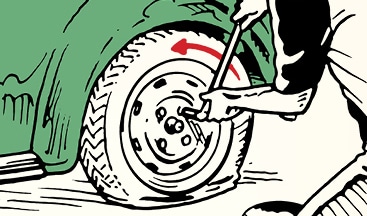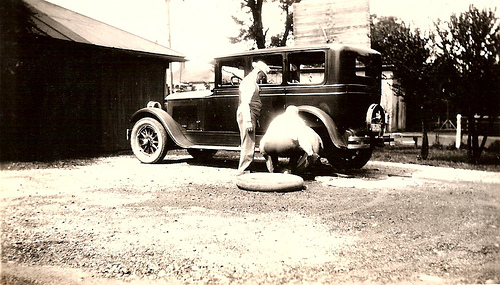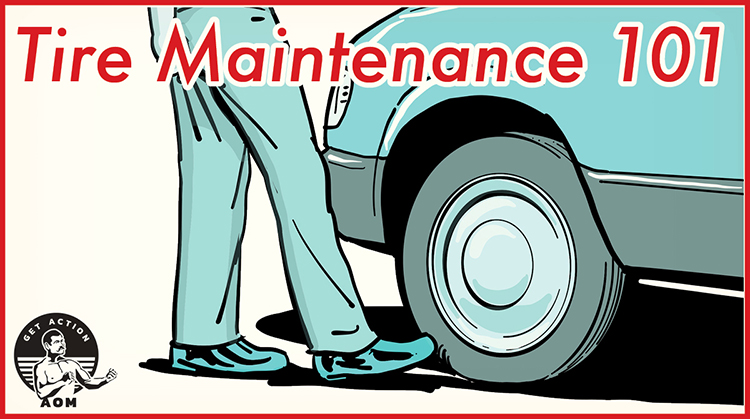
When it comes to automotive maintenance, your tires often get the short shrift. Unless you get an electronic low inflation warning up on your dashboard, you’re not apt to think about your wheels very much.
But your tires are the workhorses of your car. They’re the only thing on your vehicle that directly contacts the road. If something is off on your tires, it can cause a whole host of problems, from poor handling in lousy weather, to braking issues, to a decrease in overall fuel efficiency. In a worst-case scenario, a worn tire can blow out, potentially causing an accident.
Regular tire inspection and maintenance can nip all these problems in the bud, saving you money, and potentially even your life.
Here’s how to do it.
Your Once-a-Month Tire Inspection
You should inspect your tires at least once a month to see that they’re in proper working condition. It doesn’t take long — 10 minutes, tops.
Check Air Pressure. Maintaining proper tire pressure will keep you safe and even save you a little dough. Improperly inflated tires — and this may mean overinflated or underinflated — don’t handle or stop as well as tires with the proper pressure. Improper inflation also increases the chance of a blowout. Plus, tires with the right pressure have a longer life and improve fuel efficiency.
While all cars made since 2007 have Tire Pressure Monitoring Systems (TPMS) that warn you when a tire is either overinflated or underinflated, it’s still a good idea to test your tire pressure with an old-fashioned tire pressure gauge at least once a month. TPMS can malfunction and spit out erroneous readings. (Note: It’s also a good idea to have a mechanic check your TPMS about once a year to ensure it’s working correctly).
Checking your tire pressure takes less than two minutes. Here’s how to do it:
- For an accurate reading, always check tire pressure when your tires are “cold” before you’ve driven around on them. Tires heat up as you drive. If you’ve already been driving around for a while, let the tires “rest” for at least four hours before checking the pressure.
- Find out the tire pressure recommended for your car (it’s in your owner’s manual and on a panel inside the driver’s side door). Always fill the tires to this recommended level, regardless of tire brand, and not to the max PSI found on the tire sidewall — that number indicates the maximum pressure the tire needs to carry its heaviest load, not the tire’s ideal PSI.
- Check tire pressure with a tire pressure gauge.
- Fill when needed.
Check for Wear and Tear. Give each tire a quick look-over. You’re checking for obvious signs of wear and tear like gashes, bubbles, and embedded objects like nails and screws. If you see any of those, immediately replace the tire.
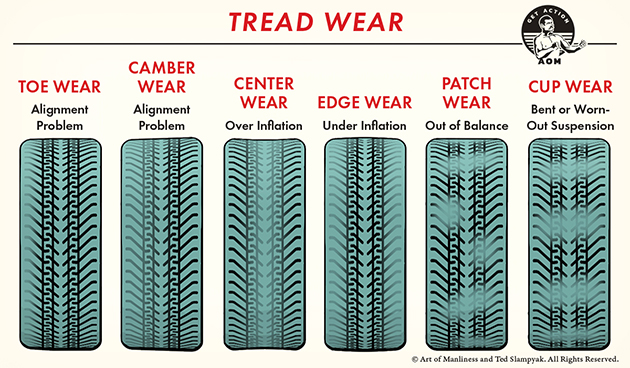
After that cursory look, check more closely for any signs of uneven wear on the tread. The type of uneven wear on your tires will indicate an underlying problem you’ll need to address.
- Toe or camber wear: Camber and toe refer to how your wheels are aligned on your car. Camber is the outward and negative tilt of the wheel. Toe refers to the direction the wheels are pointed. For example, a vehicle with the front wheels toed-in means the two front wheels are pointing together. Imagine your car’s front wheels being pigeon-toed. Camber and toe wear will cause your tires to look uneven and misshapen. If you see camber and toe wear, your car’s wheels are out of alignment.
- Center wear: If the center tread on your tire is worn, but the edges are not, it means your tire is overinflated. Too much air pressure causes the tire’s middle section to predominantly be in contact with the road.
- Edge wear: If the edges of your tire’s tread are worn, but the center is not, your tire is underinflated. Too little air pressure causes the tire’s outer edges to predominantly be in contact with the road.
- Patch or cup wear: If your tire has worn spots in random places throughout the tread, it means the wheels are out of balance or something is wrong with the suspension system.
Check Tread Depth. Tires need good tread depth to maintain traction and control of your vehicle, especially in wet conditions. As you drive your car, friction wears down the tread. The legal minimum tread depth is 2/32″. Anything below that is illegal and unsafe. To be on the safe side, most mechanics recommend that you replace your tires when the tread depth goes below 4/32″.
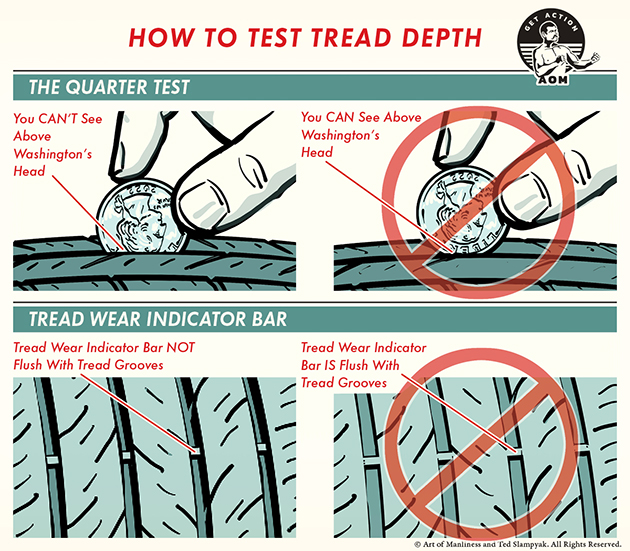
Use the quarter test to ensure that your tread depth is more than 4/32″:
- Insert a quarter into a tread groove with the top of Washington’s head facing down.
- If the top of Washington’s head is not visible, your tires have at least 4/32″ of tread and are acceptable for continued use.
- If you can see above the top of Washington’s head, it’s time to replace your tires.
Do the quarter test on the outside, middle, and inner tread grooves, as some sections may be more worn than others. For example, my front tires’ outer and inner grooves didn’t pass the quarter test, while their center grooves did (a classic case of edge wear, meaning my front tires have been underinflated for a while — whoopsies!).
Another way to check your tread depth is to look for the tread depth indicator bars. They’re little rubber squares placed between the treads all around the tire. If the tread is even and smooth with the tread bar, then your tread is worn, and you need to replace your tires.
Check Your Spare Tire. While you’re checking your working tires, you might as well check your spare tire to see if it’s ready for primetime in case you need it. Check air pressure and for wear and tear.
Regular Tire Maintenance Schedule
Inspecting your tires once a month will allow you to catch minor tire problems before they become big tire problems.
In addition to your monthly tire inspection, most car manuals recommend the following tire maintenance schedule:
Every 5,000 – 7,000 Miles: Rotate (and Balance) Tires. Front and rear tires wear differently. For example, the front tires carry more than 60% of your car’s weight; consequently, front tires wear down faster than rear ones. Also, turning wears the front tires at different rates. In America, we generally take left turns faster than right turns. This puts more load on the right front tire, which results in the right tire wearing faster than the left.
Rotating tires equalizes these natural wear patterns by changing the positions of your tires. By rotating your tires regularly, you’ll ensure yourself a smoother and safer ride. It will also save you money in the long run by extending the life of your tires.
Most experts recommend rotating your tires every 5,000 to 8,000 miles. This is an auto maintenance job you can definitely do yourself, or you can have it done at a shop. When you get your tires rotated, also have them balanced, which ensures the weight of each wheel is evenly distributed around its circumference.
Every 7,000 Miles: Wheel Alignment. As noted above, misaligned wheels will cause your tires to wear unevenly. If you notice your tires are unevenly shaped or if your car is pulling to one direction, it means your wheels are misaligned. Even if you don’t see any of the signs of misalignment, it’s a good idea to have your alignment checked every other oil change to nip any problems in the bud.
There you go. How to inspect and maintain your tires. Take care of your tires, and your tires will take care of you, keeping you safe and saving you money.
Now excuse me. Writing this article led me to discover that I need to replace the front two wheels on my Jeep before my family takes another road trip next week to Wyoming. Consider this your weekly reminder that flying is for the birds.
Illustrations by Ted Slampyak




